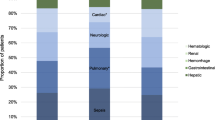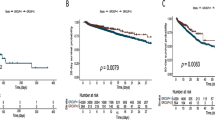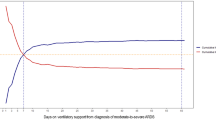Abstract
Objective: Although the acute respiratory distress syndrome (ARDS) was identified as long as 30 years ago, potential therapeutic objectives have been defined from small series rather than large trials. Moreover, relationships between ARDS and hemodynamics are unclear. The European Collaborative ARDS Study was designed to identify factors influencing the pathogenesis, severity, and prognosis of ARDS. Analysis of the hemodynamic profiles collected during this study and of their contribution to the above-mentioned facets of ARDS is the focus of the present report. Design: Prospective clinical study. Setting: 38 European intensive care units (ICUs). Patients and methods: We collected 2758 sets of data from 586 patients, including baseline data, data on proven or suspected causes of ARDS differentiating direct and nondirect lung injury, and data on baseline status including multiple organ dysfunction (MOD) with differentiation of primary ARDS from ARDS secondary to severe systemic disorders. Events during follow-up were also recorded, including whether the acute respiratory failure did or did not improve after 24 h (groups A and B, respectively). When available, hemodynamic data were recorded at enrollment (day 0), on days 1–3, 7, 14, and 21, and at discharge or at the time of death in the ICU. Results: Although the rate of preexisting disease and the nature and rate of complications varied widely among etiologic categories, differences in the hemodynamic profile occurred only between primary and secondary ARDS. Both at inclusion and during the course of the illness, variables that were used to investigate Va/Q mismatch [arterial oxygen tension (PaO2, arterial oxygen saturation, right-to-left shunt, and the PaO2/fractional inspired oxygen (FIO2) ratio] predicted survival. High pulmonary artery pressure (PAP) and low systemic artery pressure (SAP) were also related to the prognosis. In the logistic regression model including hemodynamic and oxygen-related variables, however, the only independent predictors of survival were the ratio of right over left ventricular stroke work (RVSW/LVSW) and the PaO2/FIO2 ratio at admission. On day 2, the best prognostic model included: age [odds ratio (OR) = 1.04, p = 0.0004], opportunistic pneumonia as the cause of ARDS (OR = 3.2, p = 0.03), existence of MOD (OR = 1.9, p = 0.03), PaO2/FIO2 (OR = 0.96, p = 0.005), and RVSW/LVSW (OR = 25, p = 0.02). A high RVSW/LVSW ratio, high systolic PAP, low diastolic SAP, and low PaO2/FIO2, and increased right atrial pressure were negative prognostic indicators during follow-up. Conclusion: In addition to the cause of ARDS and the early time-course of lung function, a high systolic PAP and a low diastolic SAP were strong independent indicators of survival.
Similar content being viewed by others
Author information
Authors and Affiliations
Consortia
Additional information
Received: 6 November 1997 Accepted: 8 July 1998
Rights and permissions
About this article
Cite this article
Squara, P., Dhainaut, JF., Artigas, A. et al. Hemodynamic profile in severe ARDS: results of the European Collaborative ARDS Study. Intensive Care Med 24, 1018–1028 (1998). https://doi.org/10.1007/s001340050710
Issue Date:
DOI: https://doi.org/10.1007/s001340050710




